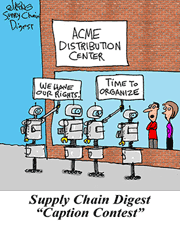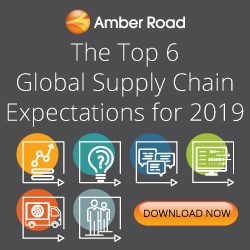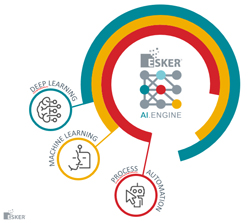The 3 V's of Supply Chain 20 Years Later
In 1998, then Gartner analyst Art Mesher developed a framework that is arguably the most well-known of any such supply chain paradigm - maybe only rivalled by the Bullwhip Effect.
That framework is the "3 V's of Supply Chain," those V's for the few who probably can't readily cite them, are Visibility, Variability and Velocity.
The funny thing is, to the best of my knowledge, the 3 V's were not - at least initially - delivered under the common analyst medium of a written "research note." Rather, the Three V's were first delivered as a presentation at a Gartner conference. Later, the Three V's construct was further elucidated in a series of research notes.
| GILMORE SAYS: |
But here Mesher makes a critical point: in the multi-party world we operate in, at the end of the day: Who owns the supply chain data?
WHAT DO YOU SAY?
Send us your
Feedback here
|
Mesher eventually went on to become CEO of supply chain software firm Descartes, where he led a remarkable turnaround and created a large amount of shareholder value.
Upon the 20 year anniversary of the first unveiling of the 3 V's, Mesher agreed to do a "part 2" in an interactive discussion at last Fall's CSCMP conference, updating, in effect, 3 V's thinking for 2019.
And with a certain appropriateness, that discussion was supported not by a written paper but by another presentation deck.
Before we look at that, a quick review of the original 3V's. In very summary fashion:
Visibility: Having a more granular and real-time view what is happening in the extended supply chain - a never ending but necessary journey.
Variability: The force that requires all kinds of expensive buffers (inventory, capacity) to be created in the supply chain, a that thus must be managed - but in some cases can be exploited. Mesher today also references "The ability to manage the unique combinations of customers, products, channels, and supply chain management processes" as core to the Variability challenge.
Velocity: At a macro and micro level, the clock speed at which a given supply operates. You may remember Dell's focus on supply chain velocity receiving much attention at about the same as the 3 V's was released.
I interviewed Mesher in 2005, and he noted that the framework was created in 1998 in large measure to encourage more companies beyond the cost reduction focus that characterized most supply chain initiatives at the time, towards those that used supply chain improvements to fuel profitable growth.
"My belief was that companies would view the 3 V's differently as they moved from a focus of saving money by cutting costs to increasing profit by growing revenues and market share," Mesher told me in 2005. "For example, saving money focused on the improving the velocity of the order-to-cash cycle, while improving profits focused on the improving the velocity of which new products and channel configurations could be created or recreated."
That battle - between viewing supply chain as primarily a cost center that serves the organization best by reducing those costs and seeing the supply chain as a revenue and customer value driver - of course continues to play out.
Mesher also noted then that the 3 V's will have different importance for different companies. "The three V's are somewhat like an equalizer in music - different songs are best heard with different settings of mid versus treble or bass," he continued. "All supply chains are not created equal; some are long (global) and very focused on coordinating and controlling material flows, working capital optimization, and channel management. Short supply chains - regional or local - tend to be more focused on service policy optimization and asset utilization. I would suspect that managers of these different types of supply chains would have different views of the priority rank of each of the three V's."
So how does Mesher view the 3 V's here in 2019?
He first nicely connects at least two of the V's - Velocity and Variability - what the profound changes are being unleashed by ecommerce.
"Private labeling foreshadowed the collapse of the competitive advantage long enjoyed by the dominant mass market brands. 20 years ago, it was sufficient to differentiate on product quality alone. Our services and logistics merely protected that inherent product value," Mesher now observes.
He adds that "Today, the window of time in which an offering maintains its advantage through product attributes and mainstream brand stature alone is collapsing. Logistics are the new differentiation, and carving a meaningful role within the discovery-to-delivery experience is the key to differentiation longevity."
Today though, Visibility is has become really just table stakes - you have to have deep levels to really compete effectively - though that is not to say there aren't still real differences between companies in terms of the Visibility they have achieved - and also can leverage.
"Knowing what has already happened no longer offers advantage," Mesher says. He also says supply chains today are characterized by "resources in motion - people, conveyance units, assets, documents, and money."
As a result "Perhaps what is needed is to have an Internet not just of things but of nouns and verbs: people, places and things all interconnecting and feeding real-time information engines that understand actions (verbs) performed by subjects (nouns) and state or place (context of action) to create end-to-end supply chain visibility," Mesher says.
 That's pretty deep. But here Mesher makes a critical point: in the multi-party world we operate in, at the end of the day: Who owns the supply chain data? To the data victors will go the spoils. He also says that we have few accepted norms about how and when supply chain data should be shared - a very good point. That's pretty deep. But here Mesher makes a critical point: in the multi-party world we operate in, at the end of the day: Who owns the supply chain data? To the data victors will go the spoils. He also says that we have few accepted norms about how and when supply chain data should be shared - a very good point.
On velocity, Mesher says "Enterprise systems and their associated processes were not designed for the environment in which we now operate. In the always-on always-connected surveillance economy, data is ubiquitous, but our systems cannot react to this information and are not built for communal process enablement."
He adds that "Tactically, we are witnessing a quest for the frictionless transaction, where things simply happen and everyone magically gets paid."
This, he says, is connected to the dream of the "smart contract," a concept generally from my view promoted under the Blockchain umbrella.
"Strategically, winning companies will harness velocity and design themselves in a way that allows them assemble and disassemble ecosystems and compete through this dynamic [supply chain] reconfiguration," Mesher says.
On the last V, Mesher says "Managing Variability strategically involves intentional planning around what needs to be standardized versus what needs to be unique."
However, there is often tension between those that wish to standardize everything - and hope to somehow avoid variability - and those that wish to compete on differentiation.
More broadly, Mesher says the companies that can reconfigure their supply chain networks and relationships with suppliers, customers and logistics service providers and execute successfully across changing ecosystems and react to ever changing requirements and threats will be the winners. (So you can say there is certainly also an element of Velocity in this view).
As a result, he also sees fewer long term partnerships, and more temporary relationships to meet needs for some finite period of time.
There is a lot more in this interesting and valuable update of the 3 V's, with much of the truly innovative thinking for which Mesher has always been known - including suggesting that we replace the long standing "4 P's" of marketing - product, place, price and promotion - with an interesting set of new P's.
You find that and the rest of the presentation here: 3Vs (Visibility, Variability, Velocity) Part 2
Any reaction to the 3V's - Then or Now? How do you see them playing out today? Let us know your thought at the Feedback button below. |



![]()

![]()

![]()













